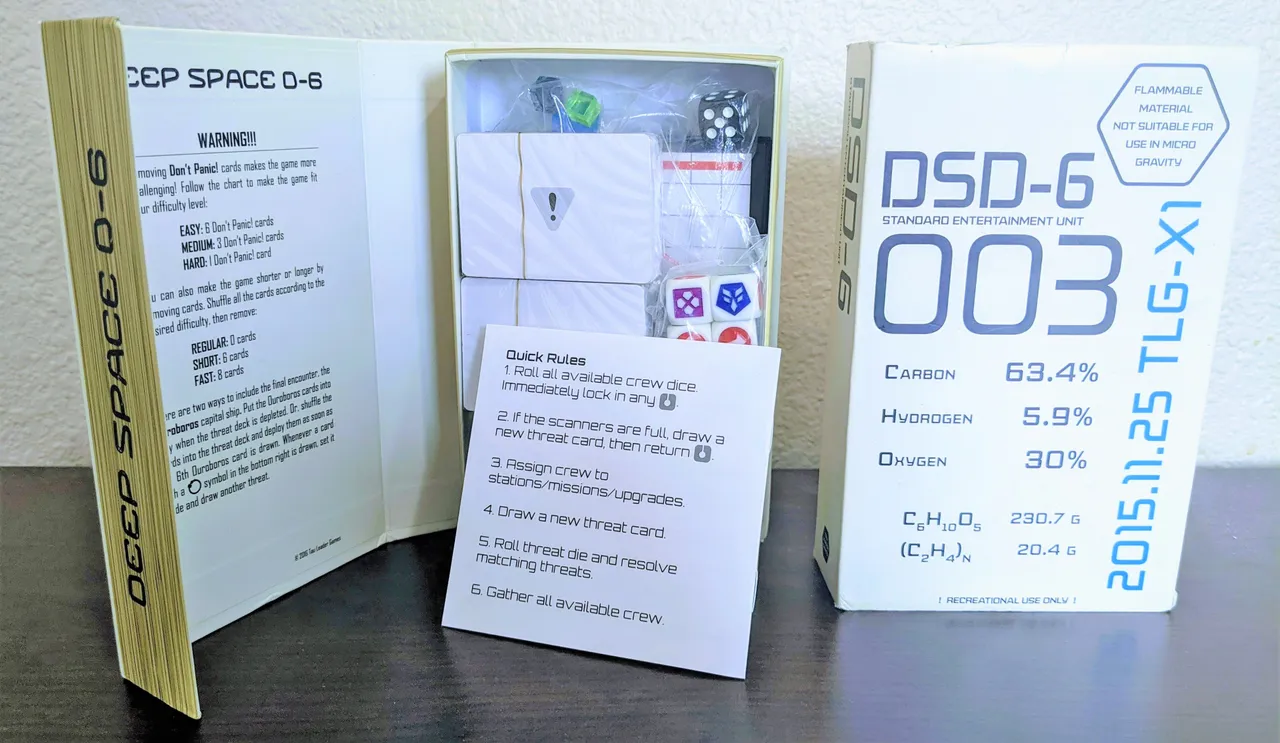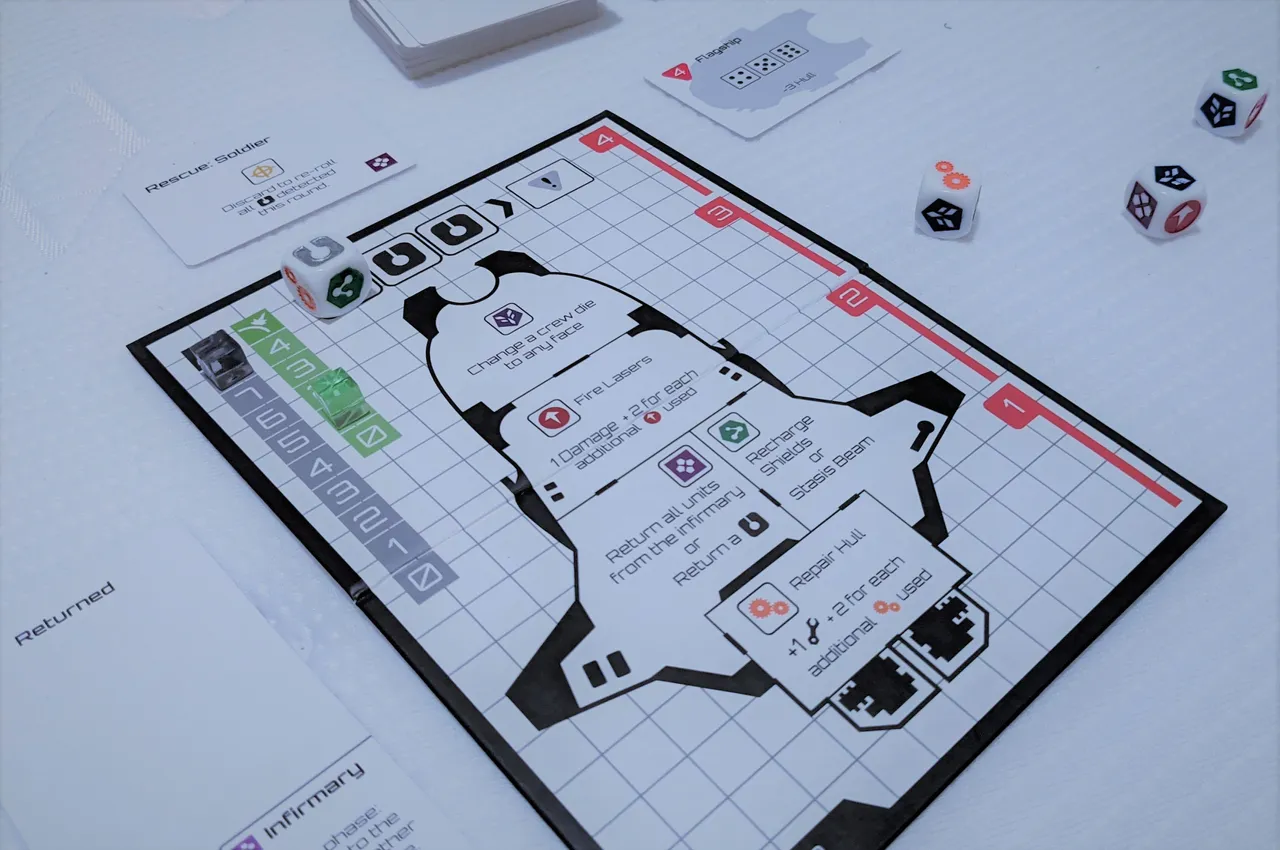Klondike Solitaire is a glory hog. It and its most popular sister, Spider, like to pretend they're the only game in town, but secretly, there are hundreds of excellent solitaire board games out there. Some are just as simple, but others can be massive solo wargames, or deeply thematic solo fantasy quests. Something pretty much all of them share in common is a reliance on random chance mechanics, to keep your cardboard enemy unpredictable. Klondike does this with cards, but it can be anything, from a bag of random tokens, to some good old fashioned dice.
Deep Space D-6, by Tony Go, is an enchanting little solo space combat game, revolving around a handful of the titular six sided dice, and a lot of ink and printer paper. You put it together yourself, is the idea, if you want the game for free - the files are freely and intentionally available online. If you want to be fancy, there were also two print runs of official published copies with custom dice and boards, though they're hard to get your hands on now. Since I'm a nerd, of course I have one, so this will be partly a review of the published version, and partly a review of the print-and-play version.

Something I immediately appreciate is that the entire game, including the Endless expansion module (not appearing in this review), dice, cards, and four custom player boards, all fits inside a teensy little box the size of an airport paperback. That's quite unreal, and it honestly feels like it must be bigger on the inside. The box itself is a magnet clasp "book" design, and in the first printing, it also came with a sleeve to keep the contents safer still. The design is excellent, and instantly evokes the theme of a sterile starship environment. Inside, this austere theme continues, with ship boards that look like blueprints and plain white borderless cards. The game has held up for half a decade of repeated play, with minimal wear and tear, so that's good component quality, even if none of it looks particularly luxurious. Except for the little custom playerboards for each ship, anyway. Those are adorable.
As for the print-and-play, your printed copy can look pretty much exactly like this if you go all out. The simple black and white design means that it'll look just as good pasted onto a box with elmer's glue, which you couldn't say of a game with more artistic complexity, as the colors would smudge, among other things. This design was probably specifically chosen for that reason, and I like that. Necessity is the mother of invention.
The rulebook is so comically poorly written that half of it is on the inner flap of the box for no reason, so it takes a while to figure it out at first, but the basic gameplay consists of rolling the dice to see which workers you get this turn, and assigning those workers to their posts to fight threat cards. Every turn, another threat appears, normally an enemy ship with a certain amount of hit points, and your job is to blast it to bits while simultaneously fixing the holes in your ship that the last threat caused. One side of each die has a threat symbol on it, and if it's rolled, it gets locked away from you, and held in a counter, instead of getting to be part of your crew. When the counter hits three, sure, those dice are freed, but you also get an extra threat. Hooray. Don't have the worker dice you need to get a job done? You can change a worker into anything you want... if you send another one of your workers to the infirmary, temporarily locking them away. Lots of things in this game lock your dice away, potentially to the point that you're rolling a single die each turn, so you've got to be careful. A ship with only one worker onboard is a sitting duck.

Early gameplay can actually be pretty dull, or if you're speaking generously, meditative. Since you start with all your dice and a beautiful new ship, you'll likely shrug off all threats one at a time, destroying each one before the next arrives. Any point in the game where you've got no backlog of threats and a full-health ship is pretty much snakes and ladders - you just go through the motions, making the obvious crew assignments. A couple on weapons, maybe one clearing out the threat meter, and that's it. This part of the game would be fine if I were recommending a game that's actually similar to klondike solitaire, but for a hobbyist board game, it doesn't cut it.
The real game happens the moment you make one or two slip-ups, or have a terrible sequence of rolls. Then, the threats start getting backed up, and suddenly you're dealing with five ships at the same time trying to blow you up in six ways. You can't kill all of them, and they're shredding your hull to bits, so where should your workers go now? Should one use the stasis beam to prevent a threat from activating this turn? That's just delaying the inevitable! Do you even have enough weapons dice to kill one of them, let alone more? Maybe you should send some crew to the infirmary to make more weapons dice, but then you're entering next turn with one less die, which is only worsening your position! Every option makes things worse, and you desperately need to choose the least awful course of action. Now, this is podracing.
Deep Space D-6 is not a strategically deep game, nor is it exactly fair, as the dice can be anything from your best friends to your worst enemies from game to game, even more so than your usual solitaire dice game. Having or not having the right die is a pretty black and white state of affairs, and not having it means you've either gotta start digging yourself into a hole sacrificing other workers to change it, or accept your inability to act. Occasionally, a die you wanted to use on one thing can instead be used on a lesser boon - for example, you wanted weapons, but shield will do - but that isn't quite the norm. Most of the time, you're adrift on a sea of total randomness, experiencing anything from no challenge to impossible odds.
I still suggest you play it. Why? It's free! Also, oddly addicting.
Not every game needs to be a direct representation of your skill. Sometimes, you can just strap in to your spaceship, sit down with a cup of tea on the porch, and see if you can squeak by this time. Even if your odds are terrible, you'll probably feel quite proud for surviving as long as you did under such brutal conditions. If your odds are in the middle, you'll have a fun and well balanced experience that'll keep you coming back. If your odds are way too good and you cheese every fight... you can always just sneakily adjust your difficulty to make things harder for yourself. Is a game where you sometimes have to do that a well designed game? Probably not, but again - it's free. Print it out, spend five minutes cutting it up, raid your other board games for a few dice, and you're good to go.
The other great thing about print-and-play games is that, as you'll notice, that file section I linked you to has fifty files, and only one of them's the base game. Some of them are fan translations, some are rethemes/art changes, a lot of them are fun new fanmade ships you can pilot with unique special abilities, hell, one of them is even a solitaire RPG to be played using Deep Space D-6 as the core. The community's creativity here is amazing, and it results in endless free expansion content for you to enjoy! Maybe you aren't sold on the base game, but you very much would be if you had the option to play with the Starship Enterprise. Guess what? You do. The only limit is our collective imaginations. There's also a lot of bonus content in the published version, if you become enamored enough to buy it.
If you're looking for other print-and-play solo games, I highly recommend starting with Sprawlopolis. If you'd prefer a solo dice game with better balance and production value, definitely try Nautilion. Finally, if you want an absolutely massive table-hogging solitaire monster with a theme and story that will make you cry, This War of Mine: The Board Game is truly special.
Alright, that's enough - ensign, take us out of here, warp two. Engage!
- V